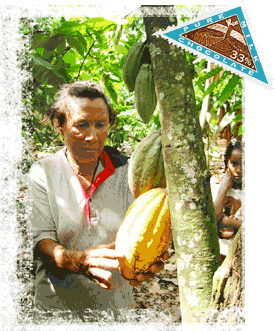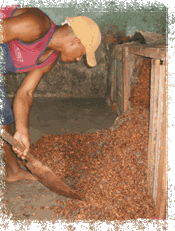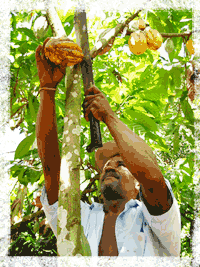Fair Trade Chocolate
by Alicia Lundquist Guy
This article was originally published in February 2003

(February 2003) — When asked what foods I most desire, fresh fruit at the peak of its season usually comes to mind first. But the quiet ruler of my culinary orchestra is chocolate — deep, earthy, grounding — like the bass thumping away in the background, keeping the beat. The music of life wouldn’t be as rich without it.
Almost everybody loves some rendition of Theobroma cacao, the “food of the gods” — a dark chocolate bar with a hint of orange, the refreshing combination of chocolate and mint, or the nostalgia of hot cocoa. This longstanding desire for chocolate has driven humans to distraction for centuries.
Chocolate is derived from the beans of cacao trees, native to the understory of South American rainforests. The Aztec people used cacao beans as currency and offerings to the gods; only the very wealthy consumed a strong beverage of chocolate and peppers. Later, the conquistadors brought chocolate back to Spain, but jealously guarded its secrets.
The Spanish controlled and expanded cacao production throughout the Caribbean and Central and South America. Europeans soon developed a taste for this exotic (and now sweetened) chocolate beverage and began establishing their own cacao plantations all over the globe: the West Indies, Brazil, Indonesia, and West Africa.

The dark side of delight
Cacao plantations have a troubling history. Rainforests were cleared to make way for rows of cacao trees which, when exposed to direct sunlight, are short-lived and more prone to disease. Harvesting cacao pods with machetes, as is still done today, was exhausting physical work. The need for labor fed the Atlantic slave trade industry, which did not come to a legal end until the late 1800s.
Sadly, a more clandestine version of forced labor still is happening on some cacao plantations today. In 2000, the British Broadcasting Company (BBC) issued a report that thousands of West African children were being stolen or bought at small cost from their poverty-stricken families and transported to cacao plantations in the Ivory Coast, where more than 40 percent of the world’s cocoa supply is currently produced.
The U.S. State Department, the International Labor Organization and UNICEF (United Nations Childrens’ Fund) have since confirmed reports of forced child labor. A study commissioned by the U.S. Senate reported in September 2001 that in the Ivory Coast, almost 12,000 children with no family ties are working on cacao plantations, wielding machetes, applying pesticides, and carrying heavy loads. Twenty-one hundred of those children were suspiciously “recruited through intermediaries.”
Consumer choices
For anyone who takes pleasure and solace in chocolate, this revelation is disturbing. Why does this happen? What is someone who wants to make conscientious food choices supposed to do? The root problem stems from the pittance that cacao farmers usually are paid for their crop. Middlemen purchase the cacao beans for a small price, using weigh scales that are often rigged. The beans then work their way through an inflationary chain until they are, most likely, purchased by a large U.S. chocolate manufacturer. According to Global Exchange, a San Francisco-based fair trade organization, “America is the world’s largest chocolate consumer. In 2000, the U.S. imported 729,000 tons of cocoa beans/processed products, ate 3.3 billion pounds of chocolate, and spent $13 billion on it.”
Members of the Chocolate Manufacturer’s Association, which represents giants like M&M/MARS, Hershey’s, Nestle, ADM Cocoa, Callebaut and Guittard (Dilettante) among others, produce 95 percent of all cocoa and chocolate sold in the United States. In a recent press release, the CMA stated, “The global chocolate and cocoa industry is launching a region-wide action program to promote responsible labor and sustainable farming practices in West African cocoa growing, in partnership with African governments, the International Labor Organization, the United States Agency for International Development, the United States Department of Labor, leading non-governmental organizations, and local farmer organizations.”
Although it is refreshing to see large-scale corporations utilizing their clout to improve the situation, their protocol is not scheduled to be fully enacted until 2005.
This leaves it up to American consumers to purchase chocolate from companies that can ensure cacao farmers and workers are treated fairly now. Many smaller-scale chocolate makers, especially in Europe, have been participating in fair trade practices for years. PCC seeks them out.
PCC’s vendors
One of the first companies to address these issues was Rapunzel Organics. In 1989, Rapunzel created the “Hand in Hand” — Ecology and Fair Trade™ program. Jim Douglass, Sales Manager at Rapunzel, says, “We always pay farmers a premium above market price. Organic farmers receive an additional price premium. One percent of the purchase price we pay to the farmer is then invested back into the local community in the form of social services.” All of Rapunzel’s cocoa beans are purchased from Bolivia and the Dominican Republic, where Rapunzel works with El Ciebo, the first certified organic cocoa cooperative.
Makers of high quality chocolates often have fair trade naturally blended into their product. John Sharffen Berger of Sharffen Berger Chocolates, a small-scale chocolate manufacturer in San Francisco, seeks out only the best cocoa beans with the unique signature of different growing regions around the world. He purchases directly from growers and pays more than double the average world price.
Sharffen Berger chocolates are not labeled to reflect these premiums — he prefers to market his chocolate solely on the merits of its quality. El Rey Chocolate also pays a premium to the Venezuelan farmers that grow its cacao, but makes little mention of it. This is a conundrum for consumers who want to know more about the origins of El Rey’s chocolate bar.

Fortunately, many more chocolate makers are putting a concerted effort into informing consumers that chocolate used in their product is purchased only from farms where farmers and workers are treated well. These companies include Tropical Source, Ben and Jerry’s, Cloud 9, Chocolove, Endangered Species Chocolate, Fran’s, and Sunspire.
Newman’s Own Organics buys its chocolate from the Organic Commodity Project, the first U.S. organic chocolate manufacturer and the largest supplier of organic chocolate. Their entire cocoa supply is purchased from small-scale farmers in Costa Rica and Panama. Nell Newman says on her Web site, “Growing the cacao in the ancient way meant that no rainforests would need to be destroyed. We can encourage this method by supporting the farmers economically.”
The most recent addition to PCC’s selection for thoughtful chocolate lovers is from progressive and well-received newcomer, Dagoba Organic Chocolate. Founder Frederick Schilling has visited the certified organic cacao cooperatives in Bolivia and the Dominican Republic where the cacao beans are grown. (It’s “cacao” before the beans are fermented and “cocoa” afterwards.) The beans are processed into cocoa liquor, cocoa powder and cocoa butter in Holland and then certified Fair Trade by the Max Havelaar Foundation, a European certifying agency. From there, Schilling blends his delectable line of chocolates, from chai milk chocolate to a more daring lime dark chocolate, at his renewable energy facility in Southern Oregon.
The global view
In September 2002, TransfairUSA, the independent third-party agency that certifies Fair Trade coffee and tea in the United States, unveiled its new Certified Fair Trade Cocoa program. Cacao-growing cooperatives representing 42,000 farmers in Belize, Bolivia, Cameroon, Costa Rica, the Dominican Republic, Ecuador, Ghana and Nicaragua are paid a global fixed minimum of 79 cents per pound.
The cooperatives are monitored for compliance every year, as are Fair Trade certified importers and chocolate makers in the United States. Dagoba is signing up with TransFair, Equal Exchange’s hot cocoa mix is certified, and Scharffen Berger works informally with TransFair to find beans from cooperatives. Considering the rapidity with which coffee and tea certification expanded, the chocolate list could be longer in a year.
We live in a time when food harkening from all over the globe can land in our kitchens in a matter of days. We are immersed in luxuries unavailable to the vast majority of fellow humans for most of history and even in the modern world today — exotic spices, fresh fruit year round, coffee and chocolate. It is an important exercise to stop every once in a while and think about the paths this food has traveled to arrive to us. Can we feel good about it, how people and the planet were treated along the way?
In a thankfully increasing number of cases, the answer is yes. Just remember that these small pleasures we often take for granted are luxuries. It will make that delectable chocolate hazelnut truffle all the sweeter.
